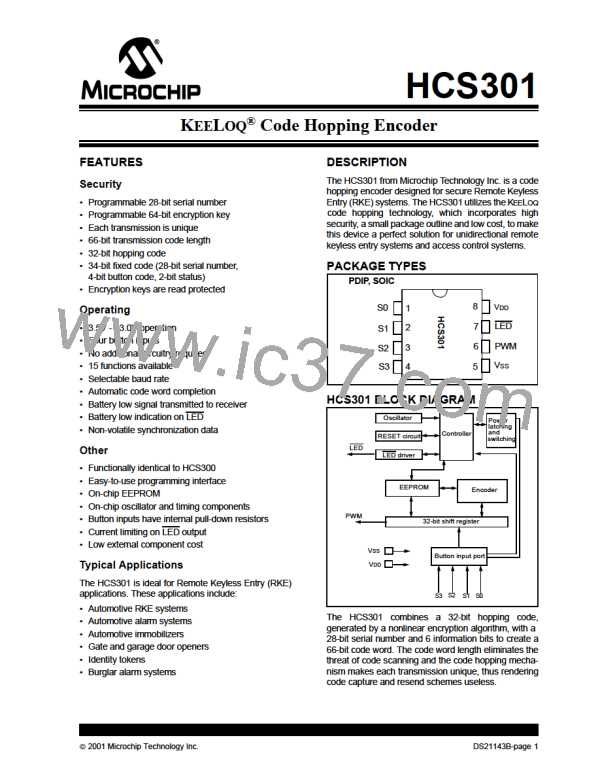HCS301
FIGURE 7-1:
TYPICAL LEARN
SEQUENCE
7.0
INTEGRATING THE HCS301
INTO A SYSTEM
Enter Learn
Use of the HCS301 in a system requires a compatible
decoder. This decoder is typically a microcontroller with
compatible firmware. Microchip will provide (via a
license agreement) firmware routines that accept
transmissions from the HCS301 and decrypt the
hopping code portion of the data stream. These
routines provide system designers the means to
develop their own decoding system.
Mode
Wait for Reception
of a Valid Code
Generate Key
from Serial Number
Use Generated Key
to Decrypt
7.1
Learning a Transmitter to a
Receiver
Compare Discrimination
Value with Fixed Value
A transmitter must first be ’learned’ by a decoder before
its use is allowed in the system. Several learning strat-
egies are possible, Figure 7-1 details a typical learn
sequence. Core to each, the decoder must minimally
store each learned transmitter’s serial number and cur-
rent synchronization counter value in EEPROM. Addi-
tionally, the decoder typically stores each transmitter’s
unique crypt key. The maximum number of learned
transmitters will therefore be relative to the available
EEPROM.
No
Equal
?
Yes
Wait for Reception
of Second Valid Code
Use Generated Key
to Decrypt
A transmitter’s serial number is transmitted in the clear
but the synchronization counter only exists in the code
word’s encrypted portion. The decoder obtains the
counter value by decrypting using the same key used
to encrypt the information. The KEELOQ algorithm is a
symmetrical block cipher so the encryption and decryp-
tion keys are identical and referred to generally as the
crypt key. The encoder receives its crypt key during
manufacturing. The decoder is programmed with the
ability to generate a crypt key as well as all but one
required input to the key generation routine; typically
the transmitter’s serial number.
Compare Discrimination
Value with Fixed Value
No
Equal
?
Yes
No
Counters
Sequential
?
Figure 7-1 summarizes a typical learn sequence. The
decoder receives and authenticates a first transmis-
sion; first button press. Authentication involves gener-
ating the appropriate crypt key, decrypting, validating
the correct key usage via the discrimination bits and
buffering the counter value. A second transmission is
received and authenticated. A final check verifies the
counter values were sequential; consecutive button
presses. If the learn sequence is successfully com-
plete, the decoder stores the learned transmitter’s
serial number, current synchronization counter value
and appropriate crypt key. From now on the crypt key
will be retrieved from EEPROM during normal opera-
tion instead of recalculating it for each transmission
received.
Yes
Learn
Unsuccessful
Learn successful Store:
Serial number
Encryption key
Synchronization counter
Exit
Certain learning strategies have been patented and
care must be taken not to infringe.
2001 Microchip Technology Inc.
DS21143B-page 15

 MICROCHIP [ MICROCHIP ]
MICROCHIP [ MICROCHIP ]